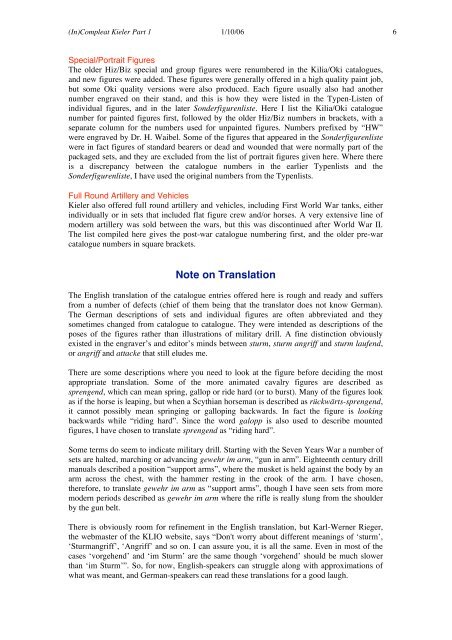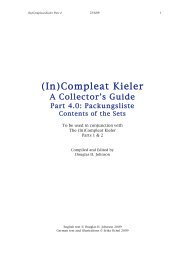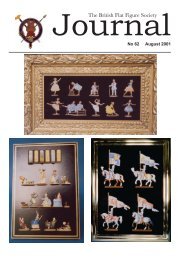The (In)Compleat Kieler
The (In)Compleat Kieler
The (In)Compleat Kieler
Sie wollen auch ein ePaper? Erhöhen Sie die Reichweite Ihrer Titel.
YUMPU macht aus Druck-PDFs automatisch weboptimierte ePaper, die Google liebt.
(<strong>In</strong>)<strong>Compleat</strong> <strong>Kieler</strong> Part 1 1/10/06 6<br />
Special/Portrait Figures<br />
<strong>The</strong> older Hiz/Biz special and group figures were renumbered in the Kilia/Oki catalogues,<br />
and new figures were added. <strong>The</strong>se figures were generally offered in a high quality paint job,<br />
but some Oki quality versions were also produced. Each figure usually also had another<br />
number engraved on their stand, and this is how they were listed in the Typen-Listen of<br />
individual figures, and in the later Sonderfigurenliste. Here I list the Kilia/Oki catalogue<br />
number for painted figures first, followed by the older Hiz/Biz numbers in brackets, with a<br />
separate column for the numbers used for unpainted figures. Numbers prefixed by “HW”<br />
were engraved by Dr. H. Waibel. Some of the figures that appeared in the Sonderfigurenliste<br />
were in fact figures of standard bearers or dead and wounded that were normally part of the<br />
packaged sets, and they are excluded from the list of portrait figures given here. Where there<br />
is a discrepancy between the catalogue numbers in the earlier Typenlists and the<br />
Sonderfigurenliste, I have used the original numbers from the Typenlists.<br />
Full Round Artillery and Vehicles<br />
<strong>Kieler</strong> also offered full round artillery and vehicles, including First World War tanks, either<br />
individually or in sets that included flat figure crew and/or horses. A very extensive line of<br />
modern artillery was sold between the wars, but this was discontinued after World War II.<br />
<strong>The</strong> list compiled here gives the post-war catalogue numbering first, and the older pre-war<br />
catalogue numbers in square brackets.<br />
Note on Translation<br />
<strong>The</strong> English translation of the catalogue entries offered here is rough and ready and suffers<br />
from a number of defects (chief of them being that the translator does not know German).<br />
<strong>The</strong> German descriptions of sets and individual figures are often abbreviated and they<br />
sometimes changed from catalogue to catalogue. <strong>The</strong>y were intended as descriptions of the<br />
poses of the figures rather than illustrations of military drill. A fine distinction obviously<br />
existed in the engraver’s and editor’s minds between sturm, sturm angriff and sturm laufend,<br />
or angriff and attacke that still eludes me.<br />
<strong>The</strong>re are some descriptions where you need to look at the figure before deciding the most<br />
appropriate translation. Some of the more animated cavalry figures are described as<br />
sprengend, which can mean spring, gallop or ride hard (or to burst). Many of the figures look<br />
as if the horse is leaping, but when a Scythian horseman is described as rückwärts-sprengend,<br />
it cannot possibly mean springing or galloping backwards. <strong>In</strong> fact the figure is looking<br />
backwards while “riding hard”. Since the word galopp is also used to describe mounted<br />
figures, I have chosen to translate sprengend as “riding hard”.<br />
Some terms do seem to indicate military drill. Starting with the Seven Years War a number of<br />
sets are halted, marching or advancing gewehr im arm, “gun in arm”. Eighteenth century drill<br />
manuals described a position “support arms”, where the musket is held against the body by an<br />
arm across the chest, with the hammer resting in the crook of the arm. I have chosen,<br />
therefore, to translate gewehr im arm as “support arms”, though I have seen sets from more<br />
modern periods described as gewehr im arm where the rifle is really slung from the shoulder<br />
by the gun belt.<br />
<strong>The</strong>re is obviously room for refinement in the English translation, but Karl-Werner Rieger,<br />
the webmaster of the KLIO website, says “Don't worry about different meanings of ‘sturm’,<br />
‘Sturmangriff’, ‘Angriff’ and so on. I can assure you, it is all the same. Even in most of the<br />
cases ‘vorgehend’ and ‘im Sturm’ are the same though ‘vorgehend’ should be much slower<br />
than ‘im Sturm’”. So, for now, English-speakers can struggle along with approximations of<br />
what was meant, and German-speakers can read these translations for a good laugh.





